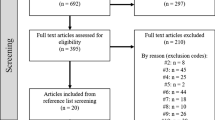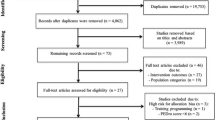Abstract
Background
Post-exercise massage is one of the most frequently applied interventions to enhance recovery of athletes. However, evidence to support the efficacy of massage for performance recovery is scarce. Moreover, it has not yet been concluded under which conditions massage is effective.
Objective
The objective of this study was to perform a systematic review and meta-analysis of the available literature on massage for performance recovery.
Methods
We conducted a structured literature search and located 22 randomized controlled trials. These were analysed with respect to performance effects and various characteristics of the study design (type and duration of massage, type of exercise and performance test, duration of recovery period, training status of subjects).
Results
Of the 22 studies, 5 used techniques of automated massage (e.g. vibration), while the other 17 used classic manual massage. A tendency was found for shorter massage (5–12 min) to have larger effects (+6.6 %, g = 0.34) than massage lasting more than 12 min (+1.0 %, g = 0.06). The effects were larger for short-term recovery of up to 10 min (+7.9 %, g = 0.45) than for recovery periods of more than 20 min (+2.4 %, g = 0.08). Although after high-intensity mixed exercise, massage yielded medium positive effects (+14.4 %, g = 0.61), the effects after strength exercise (+3.9 %, g = 0.18) and endurance exercise (+1.3 %, g = 0.12) were smaller. Moreover, a tendency was found for untrained subjects to benefit more from massage (+6.5 %, g = 0.23) than trained athletes (+2.3 %, g = 0.17).
Conclusion
The effects of massage on performance recovery are rather small and partly unclear, but can be relevant under appropriate circumstances (short-term recovery after intensive mixed training). However, it remains questionable if the limited effects justify the widespread use of massage as a recovery intervention in competitive athletes.






Similar content being viewed by others
References
Poppendieck W, Faude O, Wegmann M, et al. Cooling and performance recovery of trained athletes: a meta-analytical review. Int J Sports Physiol Perform. 2013;8(3):227–42.
Scoona GS, Hopkins WG, Mayhew S, et al. Effect of post-exercise sauna bathing on the endurance performance of competitive male runners. J Sci Med Sport. 2007;10(4):259–62.
Duffield R, Cannon J, King M. The effects of compression garments on recovery of muscle performance following high-intensity sprint and plyometric exercise. J Sci Med Sport. 2010;13(1):136–40.
Sayers SP, Clarkson PM, Lee J. Activity and immobilization after eccentric exercise: I. Recovery of muscle function. Med Sci Sports Exerc. 2000;32(9):1587–92.
Cafarelli E, Flint F. The role of massage in preparation for and recovery from exercise. An overview. Sports Med. 1992;14(1):1–9.
Moraska A. Sports massage. A comprehensive review. J Sports Med Phys Fitness. 2005;45(3):370–80.
Weerapong P, Hume PA, Kolt GS. The mechanisms of massage and effects on performance, muscle recovery and injury prevention. Sports Med. 2005;35(3):235–56.
Kosar AC, Candow DG, Putland JT. Potential beneficial effects of whole-body vibration for muscle recovery after exercise. J Strength Cond Res. 2012;26(10):2907–11.
Edge J, Mundel T, Weir K, et al. The effects of acute whole body vibration as a recovery modality following high-intensity interval training in well-trained, middle-aged runners. Eur J Appl Physiol. 2009;105(3):421–8.
Viitasalo JT, Niemela K, Kaappola R, et al. Warm underwater water-jet massage improves recovery from intense physical exercise. Eur J Appl Physiol Occup Physiol. 1995;71(5):431–8.
Hsieh LL, Kuo CH, Lee LH, et al. Treatment of low back pain by acupressure and physical therapy: randomised controlled trial. BMJ. 2006;332(7543):696–700.
Goats GC, Keir KA. Connective tissue massage. Br J Sports Med. 1991;25(3):131–3.
Best TM, Hunter R, Wilcox A, et al. Effectiveness of sports massage for recovery of skeletal muscle from strenuous exercise. Clin J Sport Med. 2008;18(5):446–60.
Crane JD, Ogborn DI, Cupido C, et al. Massage therapy attenuates inflammatory signaling after exercise-induced muscle damage. Sci Transl Med. 2012;4(119):119ra13.
Tiidus PM. Manual massage and recovery of muscle function following exercise: a literature review. J Orthop Sports Phys Ther. 1997;25(2):107–12.
Ernst E. Does post-exercise massage treatment reduce delayed onset muscle soreness? A systematic review. Br J Sports Med. 1998;32(3):212–4.
Hemmings B. Physiological, psychological and performance effects of massage therapy in sport: a review of the literature. Phys Ther Sport. 2001;2(4):165–70.
Nedelec M, McCall A, Carling C, et al. Recovery in soccer : part ii-recovery strategies. Sports Med. 2013;43(1):9–22.
Higgins JP, Altman DG, Gøtzsche PC, et al. The Cochrane Collaboration’s tool for assessing risk of bias in randomized trials. BMJ. 2011;343:d5928.
Yang Z, Scott CA, Mao C, et al. Resistance exercise versus aerobic exercise for type 2 diabetes: a systematic review and meta-analysis. Sports Med. 2014;44(4):487–99.
Morris S. Estimating effect sizes from pretest-posttest-control group designs. Organ Res Methods. 2008;11(2):364–86.
Borenstein M, Hedges LV, Higgins JPT, et al. Introduction to meta-analysis. Chichester: Wiley; 2009.
Cafarelli E, Sim J, Carolan B, et al. Vibratory massage and short-term recovery from muscular fatigue. Int J Sports Med. 1990;11(6):474–8.
Lau WY, Nosaka K. Effect of vibration treatment on symptoms associated with eccentric exercise-induced muscle damage. Am J Phys Med Rehabil. 2011;90(8):648–57.
Zainuddin Z, Newton M, Sacco P, et al. Effects of massage on delayed-onset muscle soreness, swelling, and recovery of muscle function. J Athl Train. 2005;40(3):174–80.
Harbo T, Brincks J, Andersen H. Maximal isokinetic and isometric muscle strength of major muscle groups related to age, body mass, height, and sex in 178 healthy subjects. Eur J Appl Physiol. 2012;112(1):267–75.
Nuzzo JL, McBride JM, Cormie P, et al. Relationship between countermovement jump performance and multijoint isometric and dynamic tests of strength. J Strength Cond Res. 2015;29(8):2176–85.
Alemdaroglu U. The relationship between muscle strength, anaerobic performance, agility, sprint ability and vertical jump performance in professional basketball players. J Hum Kinet. 2012;31:149–58.
Anderson MA, Gieck JH, Perrin D, et al. The relationships among isometric, isotonic, and isokinetic concentric and eccentric quadriceps and hamstring force and three components of athletic performance. J Orthop Sports Phys Ther. 1991;14(3):114–20.
Pyne DB, Saunders PU, Montgomery PG, et al. Relationships between repeated sprint testing, speed, and endurance. J Strength Cond Res. 2008;22(5):1633–7.
Wisløff U, Helgerud J, Hoff J. Strength and endurance of elite soccer players. Med Sci Sports Exerc. 1998;30(3):462–7.
Wisløff U, Castagna C, Helgerud J, et al. Strong correlation of maximal squat strength with sprint performance and vertical jump height in elite soccer players. Br J Sports Med. 2004;38(3):285–8.
Cohen J. A power primer. Psychol Bull. 1992;112(1):155–9.
Hemmings B, Smith M, Graydon J, et al. Effects of massage on physiological restoration, perceived recovery, and repeated sports performance. Br J Sports Med. 2000;34(2):109–14.
Zelikovski A, Kaye CL, Fink G, et al. The effects of the modified intermittent sequential pneumatic device (MISPD) on exercise performance following an exhaustive exercise bout. Br J Sports Med. 1993;27(4):255–9.
Mancinelli CA, Davis S, Aboulhosn L, et al. The effects of massage on delayed onset muscle soreness and physical performance in female collegiate athletes. Phys Ther Sport. 2006;7(1):5–13.
Delextrat A, Calleja-Gonzalez J, Hippocrate A, et al. Effects of sports massage and intermittent cold-water immersion on recovery from matches by basketball players. J Sports Sci. 2013;31(1):11–9.
Jönhagen S, Ackermann P, Eriksson T, et al. Sports massage after eccentric exercise. Am J Sports Med. 2004;32(6):1499–503.
Farr T, Nottle C, Nosaka K, et al. The effects of therapeutic massage on delayed onset muscle soreness and muscle function following downhill walking. J Sci Med Sport. 2002;5(4):297–306.
Hilbert JE, Sforzo GA, Swensen T. The effects of massage on delayed onset muscle soreness. Br J Sports Med. 2003;37(1):72–5.
Monedero J, Donne B. Effect of recovery interventions on lactate removal and subsequent performance. Int J Sports Med. 2000;21(8):593–7.
Sykaras E, Mylonas A, Malliaropoulos N, et al. Manual massage effect in knee extensors peak torque during short-term intense continuous concentric-eccentric isokinetic exercise in female elite athletes. Isokinet Exerc Sci. 2003;11(3):153–7.
Tiidus PM, Shoemaker JK. Effleurage massage, muscle blood flow and long-term post-exercise strength recovery. Int J Sports Med. 1995;16(7):478–83.
Ali Rasooli S, Koushkie Jahromi M, Asadmanesh A, et al. Influence of massage, active and passive recovery on swimming performance and blood lactate. J Sports Med Phys Fitness. 2012;52(2):122–127.
Lane KN, Wenger HA. Effect of selected recovery conditions on performance of repeated bouts of intermittent cycling separated by 24 hours. J Strength Cond Res. 2004;18(4):855–60.
Ogai R, Yamane M, Matsumoto T, et al. Effects of petrissage massage on fatigue and exercise performance following intensive cycle pedalling. Br J Sports Med. 2008;42(10):834–8.
Weber MD, Servedio FJ, Woodall WR. The effects of three modalities on delayed onset muscle soreness. J Orthop Sports Phys Ther. 1994;20(5):236–42.
Hopkins WG, Hawley JA, Burke LM. Design and analysis of research on sport performance enhancement. Med Sci Sports Exerc. 1999;31(3):472–85.
Hopkins WG, Hewson DJ. Variability of competitive performance of distance runners. Med Sci Sports Exerc. 2001;33(9):1588–92.
Hunter AM, Watt JM, Watt V, et al. Effect of lower limb massage on electromyography and force production of the knee extensors. Br J Sports Med. 2006;40(2):114–8.
Arabaci R. Acute effects of pre-event lower limb massage on explosive and high speed motor capacities and flexibility. J Sports Sci Med. 2008;7(4):549–55.
Callaghan MJ. The role of massage in the management of the athlete: a review. Br J Sports Med. 1993;27(1):28–33.
Dawson LG, Dawson KA, Tiidus PM. Evaluating the influence of massage on leg strength, swelling, and pain following a half-marathon. J Sports Sci Med. 2004;3(YISI 1):37–43.
Smith LL, Keating MN, Holbert D, et al. The effects of athletic massage on delayed onset muscle soreness, creatine kinase, and neutrophil count: a preliminary report. J Orthop Sports Phys Ther. 1994;19(2):93–9.
Young R, Gutnik B, Moran RW, et al. The effect of effleurage massage in recovery from fatigue in the adductor muscles of the thumb. J Manipulative Physiol Ther. 2005;28(9):696–701.
Rinder AN, Sutherland CJ. An investigation of the effects of massage on quadriceps performance after exercise fatigue. Complement Ther Nurs Midwifery. 1995;1(4):99–102.
Jeukendrup A, Saris WH, Brouns F, et al. A new validated endurance performance test. Med Sci Sports Exerc. 1996;28(2):266–70.
Andersson H, Raastad T, Nilsson J, et al. Neuromuscular fatigue and recovery in elite female soccer: effects of active recovery. Med Sci Sports Exerc. 2008;40(2):372–80.
Evans WJ, Meredith CN, Cannon JG, et al. Metabolic changes following eccentric exercise in trained and untrained men. J Appl Physiol (1985). 1986;61(5):1864–8.
Wilcock IM, Cronin JB, Hing WA. Physiological response to water immersion: a method for sport recovery? Sports Med. 2006;36(9):747–65.
Leeder J, Gissane C, van Someren K, et al. Cold water immersion and recovery from strenuous exercise: a meta-analysis. Br J Sports Med. 2012;46(4):233–40.
Halson SL. Does the time frame between exercise influence the effectiveness of hydrotherapy for recovery. Int J Sports Physiol Perform. 2011;6(2):147–59.
Wiener A, Mizrahi J, Verbitsky O. Enhancement of tibialis anterior recovery by intermittent sequential pneumatic compression of the legs. Basic Appl Myol. 2001;11(2):87–90.
Rodenburg JB, Steenbeek D, Schiereck P, et al. Warm-up, stretching and massage diminish harmful effects of eccentric exercise. Int J Sports Med. 1994;15(7):414–9.
Jakeman JR, Byrne C, Eston RG. Efficacy of lower limb compression and combined treatment of manual massage and lower limb compression on symptoms of exercise-induced muscle damage in women. J Strength Cond Res. 2010;24(11):3157–65.
Green JG, Stannard SR. Active recovery strategies and handgrip performance in trained vs. untrained climbers. J Strength Cond Res. 2010;24(2):494–501.
Moraska A. Therapist education impacts the massage effect on postrace muscle recovery. Med Sci Sports Exerc. 2007;39(1):34–7.
Author information
Authors and Affiliations
Corresponding author
Ethics declarations
Funding
This work was funded by a grant from the German Federal Institute for Sports Sciences (Bundesinstitut für Sportwissenschaft [BISp]; reference no. IIA1-081901/12-16).
Conflicts of interest
Wigand Poppendieck, Melissa Wegmann, Alexander Ferrauti, Michael Kellmann, Mark Pfeiffer and Tim Meyer declare that they have no conflicts of interest that are relevant to the content of this review.
Electronic supplementary material
Below is the link to the electronic supplementary material.
Rights and permissions
About this article
Cite this article
Poppendieck, W., Wegmann, M., Ferrauti, A. et al. Massage and Performance Recovery: A Meta-Analytical Review. Sports Med 46, 183–204 (2016). https://doi.org/10.1007/s40279-015-0420-x
Published:
Issue Date:
DOI: https://doi.org/10.1007/s40279-015-0420-x




